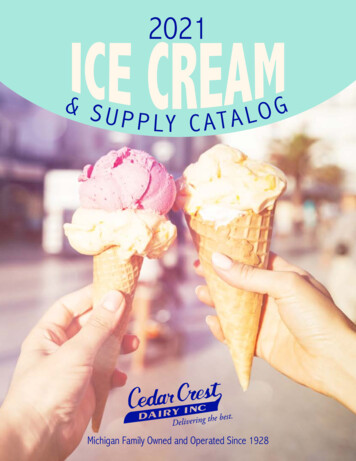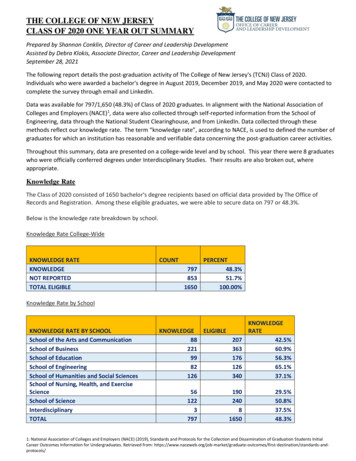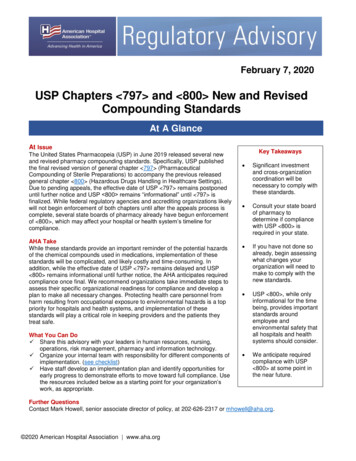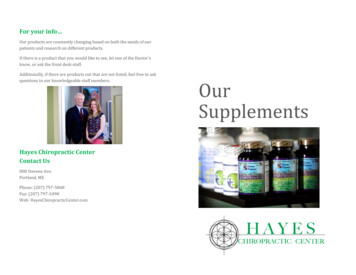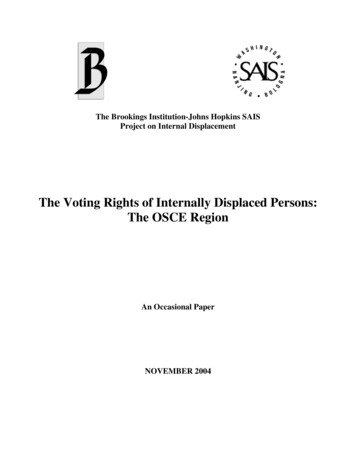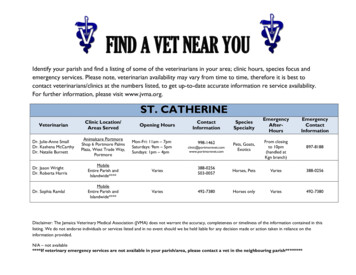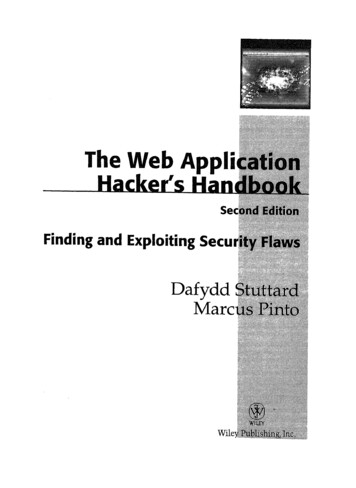
Transcription
〈797〉 Pharmaceutical Compounding—Sterile Preparations 1Revision BulletinChange to read:〈797〉 PHARMACEUTICALCOMPOUNDING—STERILE PREPARATIONSINTRODUCTIONThe objective of this chapter is to describe conditions and practices to prevent harm, includingdeath, to patients that could result from (1) microbial contamination (nonsterility), (2) excessivebacterial endotoxins, (3) variability in the intendedstrength of correct ingredients that exceeds eithermonograph limits for official articles (see “official” and “article” in the General Notices and Requirements) or 10% for nonofficial articles, (4) unintended chemical and physical contaminants, and(5) ingredients of inappropriate quality in compounded sterile preparations (CSPs). Contaminated CSPs are potentially most hazardous to patients when administered into body cavities,central nervous and vascular systems, eyes, andjoints, and when used as baths for live organs andtissues. When CSPs contain excessive bacterial endotoxins (see Bacterial Endotoxins Test 〈85〉), theyare potentially most hazardous to patients whenadministered into the central nervous system.Despite the extensive attention in this chapter tothe provision, maintenance, and evaluation of airquality, the avoidance of direct or physical contactcontamination is paramount. It is generally acknowledged that direct or physical contact of critical sites of CSPs with contaminants, especially microbial sources, poses the greatest probability ofrisk to patients. Therefore, compounding personnelmust be meticulously conscientious in precludingcontact contamination of CSPs both within andoutside ISO Class 5 (see Table 1) areas.To achieve the above five conditions and practices, this chapter provides minimum practice andquality standards for CSPs of drugs and nutrientsbased on current scientific information and beststerile compounding practices. The use of technologies, techniques, materials, and procedures otherthan those described in this chapter is not prohibited so long as they have been proven to be equivalent or superior with statistical significance tothose described herein. The standards in this chapter do not pertain to the clinical administration ofCSPs to patients via application, implantation, infusion, inhalation, injection, insertion, instillation,and irrigation, which are the routes of administration. Four specific categories of CSPs are described in this chapter: low-risk level, medium-risklevel, and high-risk level, and immediate use. Sterile compounding differs from nonsterile compounding (see Pharmaceutical Compounding—Nonsterile Preparations 〈795〉 and GoodCompounding Practices 〈1075〉) primarily by requiring the maintenance of sterility when compounding exclusively with sterile ingredients andcomponents ( i.e., with immediate-use CSPs, lowrisk level CSPs, and medium-risk level CSPs) andthe achievement of sterility when compoundingwith nonsterile ingredients and components (i.e.,with high-risk level CSPs). Some differences between standards for sterile compounding in thischapter and those for nonsterile compounding inPharmaceutical Compounding—Nonsterile Preparations 〈795〉 include, but are not limited to, ISOclassified air environments (see Table 1); personnel garbing and gloving; personnel training andtesting in principles and practices of aseptic manipulations and sterilization; environmental qualityspecifications and monitoring; and disinfection ofgloves and surfaces of ISO Class 5 (see Table 1)sources.Copyright 2008 The United States Pharmacopeial Convention All Rights Reserved.
2〈797〉 Pharmaceutical Compounding—Sterile PreparationsTable 1. ISO Classification of Particulate Matter in Room Air (limits are in particles of 0.5μm and larger per cubic meter [current ISO] andcubic feet [former Federal Standard No. 209E,FS 209E])*Class NameParticle CountFSISOU.S. FS209E,Class209EISO, m3ft33Class 135.214Class 10352105Class 1003,5201006Class 1,00035,2001,0007Class 10,000352,00010,0008Class 100,000 3,520,000100,000*Adapted from former Federal Standard No. 209E, General Services Administration, Washington, DC, 20407 (September 11, 1992)and ISO 14644-1 : 1999, Cleanrooms and associated controlled environments—Part 1: Classification of air cleanliness. For example,3,520 particles of 0.5 μm per m3 or larger (ISO Class 5) is equivalent to 100 particles per ft3 (Class 100) (1 m3 35.2 ft3).The standards in this chapter are intended to apply to all persons who prepare CSPs and all placeswhere CSPs are prepared (e.g., hospitals and otherhealthcare institutions, patient treatment clinics,pharmacies, physicians’ practice facilities, andother locations and facilities in which CSPs areprepared, stored, and transported). Persons whoperform sterile compounding include pharmacists,nurses, pharmacy technicians, and physicians.These terms recognize that most sterile compounding is performed by or under the supervision ofpharmacists in pharmacies and also that this chapter applies to all healthcare personnel who prepare,store, and transport CSPs. For the purposes of thischapter, CSPs include any of the following:(1) Compounded biologics, diagnostics, drugs,nutrients, and radiopharmaceuticals, includingbut not limited to the following dosage formsthat must be sterile when they are administered to patients: aqueous bronchial and nasalinhalations, baths and soaks for live organsand tissues, injections (e.g., colloidal dispersions, emulsions, solutions, suspensions), irrigations for wounds and body cavities, oph-Revision Bulletinthalmic drops and ointments, and tissueimplants.(2) Manufactured sterile products that are eitherprepared strictly according to the instructionsappearing in manufacturers’ approved labeling (product package inserts) or prepared differently than published in such labeling.[NOTE—The FDA states that “Compoundingdoes not include mixing, reconstituting, orsimilar acts that are performed in accordancewith the directions contained in approved labeling provided by the product’s manufacturer and other manufacturer directions consistent with that labeling” [(21 USC 321 (k)and (m)]. However, the FDA-approved labeling (product package insert) rarely describesenvironmental quality (e.g., ISO Class air designation, exposure durations to non-ISOclassified air, personnel garbing and gloving,and other aseptic precautions by which sterileproducts are to be prepared for administration). Beyond-use exposure and storage datesor times (see General Notices and Requirements and Pharmaceutical Compounding—Nonsterile Preparations 〈795〉) for sterile products that have been either opened orprepared for administration are not specifiedin all package inserts for all sterile products.Furthermore, when such durations are specified, they may refer to chemical stability andnot necessarily to microbiological purity orsafety.]ORGANIZATION OF THIS CHAPTERThe sections in this chapter are organized to facilitate the practitioner’s understanding of the fundamental accuracy and quality practices for preparing CSPs. They provide a foundation for thedevelopment and implementation of essential procedures for the safe preparation of low-risk, medium-risk, and high-risk level CSPs and immediateuse CSPs, which are classified according to the potential for microbial, chemical, and physical contamination. The chapter is divided into the following main sections:Copyright 2008 The United States Pharmacopeial Convention All Rights Reserved.
〈797〉 Pharmaceutical Compounding—Sterile Preparations 3Revision Bulletin DefinitionsResponsibility of Compounding PersonnelCSP Microbial Contamination Risk LevelsPersonnel Training and Evaluation in AsepticManipulation Skills Immediate-Use CSPs Single-Dose and Multiple-Dose Containers Hazardous Drugs as CSPs Radiopharmaceuticals as CSPs Allergen Extracts as CSPs Verification of Compounding Accuracy andSterility Environmental Quality and Control Suggested Standard Operating Procedures(SOPs) Elements of Quality Control Verification of Automated Compounding Devices (ACDs) for Parenteral NutritionCompounding Finished Preparation Release Checks andTests Storage and Beyond-Use Dating Maintaining Sterility, Purity, and Stability ofDispensed and Distributed CSPs Patient or Caregiver Training Patient Monitoring and Adverse EventsReporting Quality Assurance (QA) Program Abbreviations and Acronyms Appendices I–VThe requirements and recommendations in thischapter are summarized in Appendix I. A list of abbreviations and acronyms is included at the end ofthe main text, before the Appendices.All personnel who prepare CSPs shall be responsible for understanding these fundamentalpractices and precautions, for developing and implementing appropriate procedures, and for continually evaluating these procedures and the qualityof final CSPs to prevent harm.DEFINITIONSAnte-Area—An ISO Class 8 (see Table 1) orbetter area where personnel hand hygiene andgarbing procedures, staging of components, orderentry, CSP labeling, and other high-particulategenerating activities are performed. It is also atransition area that (1) provides assurance thatpressure relationships are constantly maintained sothat air flows from clean to dirty areas and (2) reduces the need for the heating, ventilating, and airconditioning (HVAC) control system to respond tolarge disturbances.1Aseptic Processing (see Microbiological Evaluation of Clean Rooms and Other Controlled Environments 〈1116〉)—A mode of processing pharmaceutical and medical products that involves theseparate sterilization of the product and of thepackage (containers–closures or packaging material for medical devices) and the transfer of theproduct into the container and its closure under atleast ISO Class 5 (see Table 1) conditions.Beyond-Use Date (BUD) (see General Noticesand Requirements and Pharmaceutical Compounding—Nonsterile Preparations 〈795〉)—Forthe purpose of this chapter, the date or time afterwhich a CSP shall not be stored or transported.The date is determined from the date or time thepreparation is compounded.Biological Safety Cabinet (BSC)—A ventilatedcabinet for CSPs, personnel, product, and environmental protection having an open front with inward airflow for personnel protection, downwardhigh-efficiency particulate air (HEPA)-filteredlaminar airflow for product protection, and HEPAfiltered exhausted air for environmental protection.Buffer Area—An area where the primary engineering control (PEC) is physically located. Activities that occur in this area include the preparationand staging of components and supplies used whencompounding CSPs.Clean Room (see Microbiological Evaluation ofClean Rooms and Other Controlled Environments〈1116〉 and also the definition of Buffer Area)—Aroom in which the concentration of airborne particles is controlled to meet a specified airborne particulate cleanliness class. Microorganisms in theenvironment are monitored so that a microbial1See American Society of Heating, Refrigerating and Air-Conditioning Engineers, Inc. (ASHRAE), Laboratory Design Guide.Copyright 2008 The United States Pharmacopeial Convention All Rights Reserved.
4〈797〉 Pharmaceutical Compounding—Sterile Preparationslevel for air, surface, and personnel gear are notexceeded for a specified cleanliness class.Compounding Aseptic Containment Isolator(CACI)—A compounding aseptic isolator (CAI)designed to provide worker protection from exposure to undesirable levels of airborne drugthroughout the compounding and material transferprocesses and to provide an aseptic environmentfor compounding sterile preparations. Air exchange with the surrounding environment shouldnot occur unless the air is first passed through amicrobial retentive filter (HEPA minimum) systemcapable of containing airborne concentrations ofthe physical size and state of the drug being compounded. Where volatile hazardous drugs are prepared, the exhaust air from the isolator should beappropriately removed by properly designed building ventilation.Compounding Aseptic Isolator (CAI)—Aform of isolator specifically designed for compounding pharmaceutical ingredients or preparations. It is designed to maintain an aseptic compounding environment within the isolatorthroughout the compounding and material transferprocesses. Air exchange into the isolator from thesurrounding environment should not occur unlessthe air has first passed through a microbially retentive filter (HEPA minimum).2Critical Area—An ISO Class 5 (see Table 1)environment.Critical Site—A location that includes any component or fluid pathway surfaces (e.g., vial septa,injection ports, beakers) or openings (e.g., openedampuls, needle hubs) exposed and at risk of directcontact with air (e.g., ambient room or HEPA filtered), moisture (e.g., oral and mucosal secretions), or touch contamination. Risk of microbialparticulate contamination of the critical site increases with the size of the openings and exposuretime.Direct Compounding Area (DCA)—A criticalarea within the ISO Class 5 (see Table 1) primaryengineering control (PEC) where critical sites are2CETA Applications Guide for the Use of Compounding Isolators inCompounding Sterile Preparations in Healthcare Facilities, CAG001-2005, Controlled Environment Testing Association (CETA),November 8, 2005.Revision Bulletinexposed to unidirectional HEPA-filtered air, alsoknown as first air.Disinfectant—An agent that frees from infection, usually a chemical agent but sometimes aphysical one, and that destroys disease-causingpathogens or other harmful microorganisms butmay not kill bacterial and fungal spores. It refers tosubstances applied to inanimate objects.First Air—The air exiting the HEPA filter in aunidirectional air stream that is essentially particlefree.Hazardous Drugs—Drugs are classified as hazardous if studies in animals or humans indicatethat exposures to them have a potential for causingcancer, developmental or reproductive toxicity, orharm to organs. (See current NIOSH publication.)Labeling [see General Notices and Requirements and 21 USC 321 (k) and (m)]—A term thatdesignates all labels and other written, printed, orgraphic matter on an immediate container of an article or preparation or on, or in, any package orwrapper in which it is enclosed, except any outershipping container. The term “label” designatesthat part of the labeling on the immediatecontainer.Media-Fill Test (see Microbiological Evaluation of Clean Rooms and Other Controlled Environments 〈1116〉)—A test used to qualify aseptictechnique of compounding personnel or processesand to ensure that the processes used are able toproduce sterile product without microbial contamination. During this test, a microbiological growthmedium such as Soybean–Casein Digest Mediumis substituted for the actual drug product to simulate admixture compounding.3 The issues to consider in the development of a media-fill test aremedia-fill procedures, media selection, fill volume,incubation, time and temperature, inspection offilled units, documentation, interpretation of results, and possible corrective actions required.Multiple-Dose Container (see General Noticesand Requirements and Containers for Injectionsunder Injections 〈1〉)—A multiple-unit container3U.S. Food and Drug Administration, Guidance for Industry, SterileDrug Products Produced by Aseptic Processing—Current GoodManufacturing Practice, September 2004.Copyright 2008 The United States Pharmacopeial Convention All Rights Reserved.
Revision Bulletin〈797〉 Pharmaceutical Compounding—Sterile Preparations 5for articles or preparations intended for parenteraladministration only and usually containing antimicrobial preservatives. The beyond-use date (BUD)for an opened or entered (e.g., needle-punctured)multiple-dose container with antimicrobial preservatives is 28 days (see Antimicrobial Effectiveness Testing 〈51〉), unless otherwise specified bythe manufacturer.Negative Pressure Room—A room that is at alower pressure than the adjacent spaces and, therefore, the net flow of air is into the room.1Pharmacy Bulk Package (see Containers forInjections under Injections 〈1〉)—A container of asterile preparation for parenteral use that containsmany single doses. The contents are intended foruse in a pharmacy admixture program and are restricted to the preparation of admixtures for infusion or, through a sterile transfer device, for thefilling of empty sterile syringes. The closure shallbe penetrated only one time after constitution witha suitable sterile transfer device or dispensing set,which allows measured dispensing of the contents.The pharmacy bulk package is to be used only in asuitable work area such as a laminar flow hood (oran equivalent clean air compounding area).Where a container is offered as a pharmacy bulkpackage, the label shall (a) state prominently“Pharmacy Bulk Package—Not for Direct Infusion,” (b) contain or refer to information on propertechniques to help ensure safe use of the product,and (c) bear a statement limiting the time frame inwhich the container may be used once it has beenentered, provided it is held under the labeled storage conditions.Primary Engineering Control (PEC)—A device or room that provides an ISO Class 5 (see Table 1) environment for the exposure of critical siteswhen compounding CSPs. Such devices include,but may not be limited to, laminar airflow workbenches (LAFWs), biological safety cabinets(BSCs), compounding aseptic isolators (CAIs),and compounding aseptic containment isolators(CACIs).Preparation—A preparation, or a CSP, that is asterile drug or nutrient compounded in a licensedpharmacy or other healthcare-related facility pur-suant to the order of a licensed prescriber; the article may or may not contain sterile products.Product—A commercially manufactured steriledrug or nutrient that has been evaluated for safetyand efficacy by the FDA. Products are accompanied by full prescribing information, which is commonly known as the FDA-approved manufacturer’s labeling or product package insert.Positive Pressure Room—A room that is at ahigher pressure than the adjacent spaces and,therefore, the net airflow is out of the room.1Single-Dose Container (see General Noticesand Requirements and Containers for Injectionsunder Injections 〈1〉)—A single-dose container is asingle-unit container for articles (see General Notices and Requirements) or preparations intendedfor parenteral administration only. It is intendedfor a single use. A single-dose container is labeledas such. Examples of single-dose containers include prefilled syringes, cartridges, fusion-sealedcontainers, and closure-sealed containers when solabeled.Segregated Compounding Area—A designatedspace, either a demarcated area or room, that is restricted to preparing low-risk level CSPs with 12hour or less BUD. Such area shall contain a devicethat provides unidirectional airflow of ISO Class 5(see Table 1) air quality for preparation of CSPsand shall be void of activities and materials thatare extraneous to sterile compounding.Sterilizing Grade Membranes—Membranesthat are documented to retain 100% of a culture of107 microorganisms of a strain of Brevundimonas(Pseudomonas) diminuta per square centimeter ofmembrane surface under a pressure of not less than30 psi (2.0 bar). Such filter membranes are nominally at 0.22-μm or 0.2-μm nominal pore size, depending on the manufacturer’s practice.Sterilization by Filtration—Passage of a fluidor solution through a sterilizing grade membraneto produce a sterile effluent.Terminal Sterilization—The application of alethal process (e.g., steam under pressure orautoclaving) to sealed containers for the purposeof achieving a predetermined sterility assuranceCopyright 2008 The United States Pharmacopeial Convention All Rights Reserved.
6〈797〉 Pharmaceutical Compounding—Sterile Preparationslevel of usually less than 10 6, or a probability ofless than one in one million of a nonsterile unit.3Unidirectional Flow (see footnote 3)—An airflow moving in a single direction in a robust anduniform manner and at sufficient speed toreproducibily sweep particles away from the critical processing or testing area.RESPONSIBILITY OF COMPOUNDINGPERSONNELCompounding personnel are responsible for ensuring that CSPs are accurately identified, measured, diluted, and mixed and are correctly purified,sterilized, packaged, sealed, labeled, stored, dispensed, and distributed. These performance responsibilities include maintaining appropriatecleanliness conditions and providing labeling andsupplementary instructions for the proper clinicaladministration of CSPs.Compounding supervisors shall ensure, througheither direct measurement or appropriate information sources, that specific CSPs maintain their labeled strength within monograph limits for USParticles, or within 10% if not specified, until theirBUDs. All CSPs are prepared in a manner thatmaintains sterility and minimizes the introductionof particulate matter.A written quality assurance procedure includesthe following in-process checks that are applied, asappropriate, to specific CSPs: accuracy and precision of measuring and weighing; the requirementfor sterility; methods of sterilization and purification; safe limits and ranges for strength of ingredients, bacterial endotoxins, and particulate matter;pH; labeling accuracy and completeness; BUD assignment; and packaging and storage requirements. The dispenser shall, when appropriate andpracticable, obtain and evaluate results of testingfor identity, strength, purity, and sterility before aCSP is dispensed. Qualified licensed healthcareprofessionals who supervise compounding and dispensing of CSPs shall ensure that the followingobjectives are achieved:1. Compounding personnel are adequatelyskilled, educated, instructed, and trained to2.3.4.5.6.7.Revision Bulletincorrectly perform and document the followingactivities in their sterile compounding duties:a. perform antiseptic hand cleansing anddisinfection of nonsterile compoundingsurfaces;b. select and appropriately don protectivegarb;c. maintain or achieve sterility of CSPs inISO Class 5 (see Table 1) PEC devicesand protect personnel and compoundingenvironments from contamination by radioactive, cytotoxic, and chemotoxicdrugs (see Hazardous Drugs as CSPs andRadiopharmaceuticals as CSPs);d. identify, weigh, and measure ingredients;ande. manipulate sterile products aseptically,sterilize high-risk level CSPs, and labeland quality inspect CSPs.Ingredients have their correct identity, quality,and purity.Opened or partially used packages of ingredients for subsequent use in CSPs are properlystored under restricted access conditions inthe compounding facility. Such packages cannot be used when visual inspection detects unauthorized breaks in the container, closure,and seal; when the contents do not possess theexpected appearance, aroma, and texture;when the contents do not pass identificationtests specified by the compounding facility;and when either the BUD or expiration datehas been exceeded.Water-containing CSPs that are nonsterileduring any phase of the compounding procedure are sterilized within 6 hours after completing the preparation in order to minimizethe generation of bacterial endotoxins.Sterilization methods achieve sterility ofCSPs while maintaining the labeled strengthof active ingredients and the physical integrityof packaging.Measuring, mixing, sterilizing, and purifyingdevices are clean, appropriately accurate, andeffective for their intended use.Potential harm from added substances andCopyright 2008 The United States Pharmacopeial Convention All Rights Reserved.
Revision Bulletin〈797〉 Pharmaceutical Compounding—Sterile Preparations 7differences in rate and extent of bioavailability of active ingredients for other than oralroute of administration are carefully evaluatedbefore such CSPs are dispensed andadministered.8. Packaging selected for CSPs is appropriate topreserve the sterility and strength until theBUD.9. While being used, the compounding environment maintains the sterility or the presterilization purity, whichever is appropriate, of theCSP.10. Labels on CSPs list the names and amounts orconcentrations of active ingredients, and thelabels or labeling of injections (see Preservation, Packaging, Storage, and Labeling in theGeneral Notices and Requirements) list thenames and amounts or concentrations of allingredients (see Injections 〈1〉). Before beingdispensed or administered, the clarity of solutions is visually confirmed; also, the identityand amounts of ingredients, procedures toprepare and sterilize CSPs, and specific release criteria are reviewed to ensure their accuracy and completeness.11. BUDs are assigned on the basis of direct testing or extrapolation from reliable literaturesources and other documentation (see Stability Criteria and Beyond-Use Dating underPharmaceutical Compounding—NonsterilePreparations 〈795〉).12. Procedures for measuring, mixing, dilution,purification, sterilization, packaging, and labeling conform to the correct sequence andquality established for the specified CSP.13. Deficiencies in compounding, labeling, packaging, and quality testing and inspection canbe rapidly identified and corrected.14. When time and personnel availability so permit, compounding manipulations and procedures are separated from postcompoundingquality inspection and review before CSPs aredispensed.This chapter emphasizes the need to maintainhigh standards for the quality and control ofprocesses, components, and environments and forthe skill and knowledge of personnel who prepareCSPs. The rigor of in-process quality-controlchecks and of postcompounding quality inspectionand testing increases with the potential hazard ofthe route of administration. For example, nonsterility, excessive bacterial endotoxin contamination,large errors in strength of correct ingredients, andincorrect ingredients in CSPs are potentially moredangerous to patients when the CSPs are administered into the vascular and central nervous systemsthan when administered by most other routes.CSP MICROBIAL CONTAMINATION RISKLEVELSThe three contamination categories for CSPs described in this section are assigned primarily according to the potential for microbial contamination during the compounding of low-risk levelCSPs and medium-risk level CSPs or the potentialfor not sterilizing high-risk level CSPs, any ofwhich would subject patients to risk of harm, including death. High-risk level CSPs must be sterilized before being administered to patients. The appropriate risk level—low, medium, or high—isassigned according to the corresponding probability of contaminating a CSP with (1) microbial contamination (e.g., microbial organisms, spores, endotoxins) and (2) chemical and physicalcontamination (e.g., foreign chemicals, physicalmatter). Potential sources of contamination include, but are not limited to, solid and liquid matter from compounding personnel and objects; nonsterile components employed and incorporatedbefore terminal sterilization; inappropriate conditions within the restricted compounding environment; prolonged presterilization procedures withaqueous preparations; and nonsterile dosage formsused to compound CSPs.The characteristics described below for low-,medium-, and high-risk level CSPs are intended asa guide to the breadth and depth of care necessaryin compounding, but they are neither exhaustivenor prescriptive. The licensed healthcare professionals who supervise compounding are responsible for determining the procedural and environ-Copyright 2008 The United States Pharmacopeial Convention All Rights Reserved.
8〈797〉 Pharmaceutical Compounding—Sterile Preparationsmental quality practices and attributes that arenecessary for the risk level they assign to specificCSPs.These risk levels apply to the quality of CSPsimmediately after the final aseptic mixing or filling or immediately after the final sterilization, unless precluded by the specific characteristics of thepreparation. Upon subsequent storage and shippingof freshly finished CSPs, an increase in the risks ofchemical degradation of ingredients, contamination from physical damage to packaging, and permeability of plastic and elastomeric packaging isexpected. In such cases, compounding personnelare responsible for considering the potential additional risks to the integrity of CSPs when assigningBUDs. The pre-administration storage durationand temperature limits specified in the followingsubsections apply in the absence of direct sterilitytesting results that justify different limits for specific CSPs.Low-Risk Level CSPsCSPs compounded under all the following conditions are at a low risk of contamination.Low-Risk Conditions—1. The CSPs are compounded with aseptic manipulations entirely within ISO Class 5 (seeTable 1) or better air quality using only sterileingredients, products, components, anddevices.2. The compounding involves only transfer,measuring, and mixing manipulations usingnot more than three commercially manufactured packages of sterile products and notmore than two entries into any one sterilecontainer or package (e.g., bag, vial) of sterileproduct or administration container/device toprepare the CSP.3. Manipulations are limited to aseptically opening ampuls, penetrating disinfected stopperson vials with sterile needles and syringes, andtransferring sterile liquids in sterile syringesto sterile administration devices, package containers of other sterile products, and containers for storage and dispensing.4.Revision BulletinFor a low-risk level preparation, in the absence of passing a sterility test (see SterilityTests 〈71〉), the storage periods cannot exceedthe following time periods: before administration, the CSPs are properly stored and are exposed for not more than 48 hours at controlledroom temperature (see General Notices andRequirements), for not more than 14 days at acold temperature (see General Notices andRequirements), and for 45 days in solid frozenstate between 25 and
The objective of this chapter is to describe con- scribed in this chapter: low-risk level, medium-risk ditions and practices to prevent harm, including level, and high-risk level, and immediate use. . and tissue ter in Room Air (limits are in particles of 0.5 implants. μm and larger per cubic meter [current ISO] and(2) Manufactured sterile .

